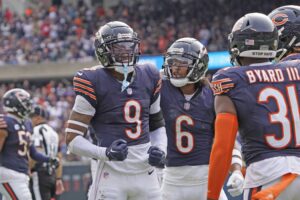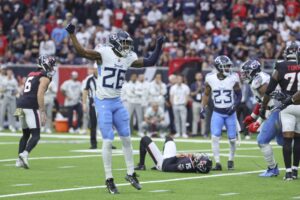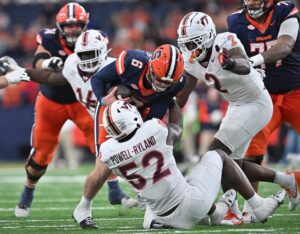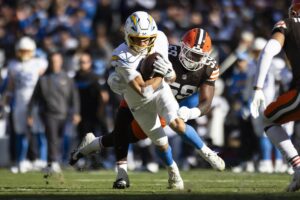Divisional matchups for the Kansas City Chiefs have been the lifeblood of their season, the oft pivotal point that nails the Chiefs as a legitimate threat. No matter how down or strong the AFC West is, from year to year, the bottom and top of the division has a propensity to epitomize the term “any given Sunday.” Facing the 0-2 Los Angeles Chargers on Sunday may seem a lighter task than the first two games of the season. Yet the Chargers schematically and mentally compose a crafted threat to all their AFC West opponents. Notably, the Chargers have only lost their first two games due to egregious late game errors. Defending their new (temporary) home in Carson, California, the Chargers mental aptitude provides a trap game narrative. Yet, the Chiefs scheme can contain Philip Rivers and utilize their power running game to wear down the Chargers defense to continue physical dominance.
Kansas City Chiefs Scheme Breakdown – Controlling Temperament
Controlling Flow of the Game
One of the central tenants of the Chargers defensive scheme is to let defensive ends Melvin Ingram and Joey Bosa get to the quarterback, thus allowing a tentative secondary to stay composed and battle receivers throughout their routes. Again, the offensive line play will need to be structure A for the Chiefs to win. Allowing Alex Smith enough time to find targets in precise crossing routes is of the utmost importance.
Gus Bradley coordinates his defense in a unique way, allowing more free-ranging in his cover three set. Casey Hayward and Jason Verrett operate in man coverage on the corners, rarely rotating sides. Consequently, the safeties float deep as true midfielders. Thus, the emphatic notion of the secondary is to allow blitz packages. Again, Ingram and Bosa are point and tangent to their success.
By focusing defensive pressure on the edge, the Chargers can then set to a tighter set that moves Bosa to the interior for pressure and adhering a double-team, subsequently launching Brandon Mebane free into the interior lane to stuff running lanes.
However, while the Chargers scheme appears to work on paper, they lack weight in the linebacker system, and have a faux system in operation with sub optimal blitz packages. Jatavis Brown has taken the entire onus of creating chaos and finishing plays. Hence, if Kareem Hunt can get into the second level, he ought to create some powerful runs.
Through the first two games, the Chargers allowed 140 yards rushing to the Denver Broncos corps, and 122 yards to Miami Dolphins workhorse back Jay Ajayi.
Hunt’s running game will point to the way the Chiefs control the flow of the game. Smith and the offense have been able to find rhythm in the first two weeks, setting that rhythm through the running game. Head coach Andy Reid may also intertwine variable backfield formations to widen out runs with De’Anthony Thomas or Albert Wilson.
Setting up run plays will go on to open up the passing scheme. The middle of the field is vulnerable for the Chargers. Middle fielder Tre Boston is an aggressive safety who will be able to negate Travis Kelce about half the time. The Boston and Kelce matchup downfield will be an incredible fight throughout the game.
However, the middle and short lanes have been exposed over the first two games. Playing quarterbacks Trevor Siemian and Jay Cutler, the Chargers linebackers have been exposed when attempting to cover. Thus, if Tyreek Hill and Chris Conley are used down the sidelines, demanding the attention of the more talented corners, Kelce and Hunt will become premium targets in the short and middle ranges against linebackers and slower corners.
The ability of Smith to sort through defenses and manage the middle of the field will be enough to beat the Chargers. However, to offer a safe and convincing result on Sunday, a plethora of short passes to the middle ought to pull Boston and Hayward up in coverage, allowing Hill to explode for an explosive second half touchdown. After all, the Chargers defense is the seventh worst at giving up explosive passes.
Defense Unsettling the Status Quo
Controlling the ball against the Los Angeles Chargers will invariably assist the defense. Make no mistake: Rivers is still a quarterback who can get into a rhythm and shred even the best. The veteran signal caller has connected on 73.6 percent of his passes through two games and has been incredibly efficient against two quality defenses.
However, the problem for Rivers is his lack of weapons and a struggling running game. The Chargers offensive line has only allowed two sacks, but that stat could change if Dee Ford and Chris Jones combine to continue their defensive prowess. The key to beating the Chargers is by unsettling their status quo attack.
While Rivers is a veteran with the ability to come back late, the rest of the Chargers are permeating in a culture of losing. There is a certain element of truth to the psychological phenomenon of a consistent losing culture. And the Chargers first two losses have them stewing in that mentality, thus killing any hope early will end the Chargers will to win.
Making the Chargers offense a linear attack starts with stopping the run, and then putting Daniel Sorensen on Antonio Gates to mitigate those middle routes that Rivers has thrived upon. Sorensen has a tall task this week in stopping Gates, thus a linebacker such as Derrick Johnson or even Ford will be ordered with chipping him on the line to delay his route. The necessity of the delay hit on Gates has gone far to helping the Chargers pass protection. Again, asserting a pass rush early ought to reverse the role, and force Gates to stay in and chip-block Ford by necessitation.
The pass rush and middle route coverage go hand-in-hand for success. Create pressure and Gates loses freedom to run in the route tree. This will give Sorensen and Ron Parker time to battle against Gates and Hunter Henry.
Rivers’ deep passing game, on paper, has the potential to result in highly explosive plays. Travis Benjamin and Keenan Allen are both deep threats with the ability to get over the top of defenders. However, the Chiefs have excelled so far at protecting against deep passes, allowing less than 50 percent success across the board. The only singular area they have allowed more than 50 percent is the deep right at 60 percent success.
Further, the Chargers receivers, other than Allen, have yet to receive targeted success. The longest pass completed from Rivers is 38 yards. The physical play from Phillip Gaines, Parker, and Terrance Mitchell ought to continue the disallowance of Chargers receivers to go deep.
Marcus Peters, who has quietly excelled, may have his first pick of the season if he is one on one with Allen. Allen has a lack of hand-combat skills downfield, and thus is in stark contrast to the physicality Peters plays with. Rivers is a smart quarterback, but being a potent veteran, may not entirely avoid Peters.
But as mentioned before, Rivers can get going at any point in a game if he is allowed time and comfort. Thus, bottling the Chargers running back will throw their entire scheme out of orbit. Melvin Gordon has only averaged 2.5 yards per carry with 67 total yards: hardly passable for electric.
The Chargers plan of attack with their running game is to throw in a change of pace in play calling to standard tight end formations with intent of setting up play action passes. Those plays subsequently release Gates, Henry, and Gordon into the flats for efficient and consistent passing plays.
Gordon may be better utilized as a receiver than a running back against the Chiefs. He is an electric runner on the exterior, and may offer some substance on screen passes. The screen game, however, will be swallowed by the Chiefs linebackers. If Allen Bailey and Bennie Logan shut down the interior lanes early, the Chargers scheme will be forced into the lanes of Houston and Johnson; a duo of linebackers who shall not be passed.
Summarizing the Plan of Attack
Schematically, the Chiefs have the talent, athleticism, and intangibles to beat the Chargers through four quarters. The Chiefs can throw off the Chargers intentions early and force them out of sync on offense. Again, it begins with the exterior pass rush, shutting down Rivers, and forcing the game into the path of astutely physical linebackers.
Once the ball is in the hands of Smith and the offense, pacing away with Hunt and the running game will tire out the Chargers lackluster linebackers. If the offensive line stops the pass rush, Smith will be able to transition efficiently to targeted crossing routes that have shown success over the first two weeks. Smith doesn’t need to be explosive; he just needs to set the table and execute to open up the optimal explosive plays.
Main Image:






